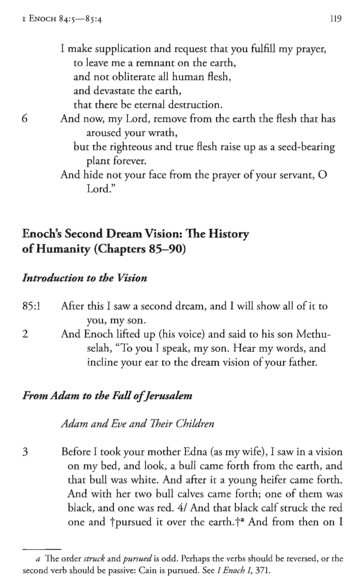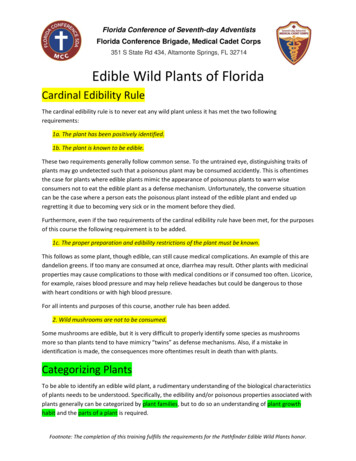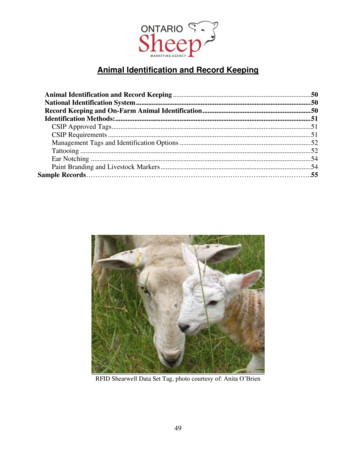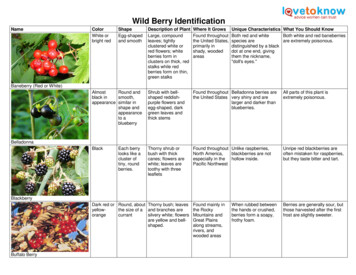
Transcription
Wild Berry IdentificationNameColorWhite orbright redShapeEgg-shapedand smoothDescription of PlantLarge, compoundleaves; tightlyclustered white orred flowers; whiteberries form inclusters on thick, redstalks while redberries form on thin,green stalksWhere It GrowsFound throughoutthe United States,primarily inshady, woodedareasUnique Characteristics What You Should KnowBoth red and whiteBoth white and red baneberriesspecies areare extremely poisonous.distinguished by a blackdot at one end, givingthem the nickname,"doll's eyes."AlmostRound andblack insmooth,appearance similar inshape andappearanceto ablueberryShrub with bellshaped reddishpurple flowers andegg-shaped, darkgreen leaves andthick stemsFound throughout Belladonna berries arethe United States very shiny and arelarger and darker thanblueberries.All parts of this plant isextremely poisonous.BlackThorny shrub orbush with thickcanes; flowers arewhite; leaves aretoothy with threeleafletsFound throughout Unlike raspberries,North America,blackberries are notespecially in the hollow inside.Pacific NorthwestUnripe red blackberries areoften mistaken for raspberries,but they taste bitter and tart.Found mainly inthe RockyMountains andGreat Plainsalong streams,rivers, andwooded areasBerries are generally sour, butthose harvested after the firstfrost are slightly sweeter.Baneberry (Red or White)BelladonnaEach berrylooks like acluster oftiny, roundberries.BlackberryDark red or Round, about Thorny bush; leavesyellowthe size of a and branches areorangecurrantsilvery white; flowersare yellow and bellshaped.Buffalo BerryWhen rubbed betweenthe hands or crushed,berries form a soapy,frothy foam.
Dark redpurpleOblong,Thornless tree orabout theshrub; leaves aresize of a pea dull, green, andserrated; flowers aretiny white cylindricalclustersFound throughout Each fruit contains onethe United States, large pit.especially in theAppalachianMountains andalong riverbanksin dense thicketsPits and leaves are poisonousand contain a small amount ofcyanide, which can bedestroyed through cooking ordrying.RedRound, looks Trailing vines withvery similarsmall pinkish-yellow,to a currantbell-shaped flowers;tiny, evergreenleavesFound in bogs,marshes, oralong streams,especially inMassachusetts,New Jersey,Wisconsin,Washington, andOregonCranberry stems arevery thin and wiry.Cranberries are usuallyfound in moist soil.Berries are sweetest after thefirst frost.DarkpurpleblackClusters oftiny, round,seed-likeberriesThornless shrub orsmall tree with tiny,white, clusteredflowers (flowersresemble a tinyhoneysuckle); leavesare flatForests andwoodlandsthroughout theUnited StatesElderberries grow in flat Avoid green berries as theyclusters and aremay make you sick.thornless.Dark blueor purpleblackSmall, roundberries,resembling ablueberryShrub grows indense thicketsapproximately fourfeet tall; flowers arebell-shaped; leavesturn bronze orreddish purple in thefallFound primarily in Each huckleberrythe Pacificcontains ten, hardNorthwestern and seeds.Northeasternregions,especially onmountain kleberries are oftenmistaken as blueberries butcan be distinguished by theirhard seeds and blue-blackcolor.
BlueRound,resembles ablueberryA Juniper can be aFound throughouttall tree or smallerthe United Statesshrub; leaves areneedle-like, verysharp and evergreenJuniper bark is thin witha distinctive scent(similar to cedar) andcomes off in strips.Berries are edible but bitter andmay cause severe stomachupset in some people.Red toblackEachmulberry isoval andmade up ofmany tinyberriesVery tall tree growing Found throughoutup to 60 feet;the United Statesserrated leaves areusually oval withthree lobes; flowersare small, fuzzy,white clustersMulberries look similarto raspberries orblackberries but aremore oval and notround.Unripe berries or sap may betoxic or hallucinogenic. Berriesdo not keep well and should beused quickly.Bright redEach berry isa cluster oftiny, roundberriesBramble (shrub) with Found throughoutthorned canes;the United Statesflowers have whitepetals with yellowcenter; leaves havethree to five leafletsAll raspberries arehollow. When araspberry is picked, itleaves behind itsreceptacle.Raspberry leaves are alsoedible and often used in herbalteas.RedHollowberriesresembleraspberries,but are flatterand smallerDense shrub thatgrows in clumps;fuzzy leaves containfive lobes; flowersare white and starshaped.Leaves closelyresemble those of amaple tree. Fruit ishollow, resembling athimble.Fruit is tart and contains manyseeds.Juniper BerryMulberryRed RaspberryThimbleberryFound throughoutthe United States,especially aroundrailroad tracks,forest edges, andalong roadsides
BlueRound,Climbing vine; leavesresembling a have five leafletsblueberrywith many teeth;flowers are tinygreen clusters.Found throughoutthe United States,especially in theeastern regionsVirginia creeper is often Berries are extremely toxic toconfused with poison ivy humans.and often found growingalongside poison ivy.Blue-blackRound with a5-pointed"crown" onone endShrub with thinbranches; flowersare white or lightpink; leaves arebroad and oftenevergreen.Found throughoutthe United States,especially inMaine and NewJerseyWild blueberries aresmaller thanconventionally grownblueberries; the berriescontain many small, softseeds.Wild blueberries are oftenconfused with huckleberries butare much lighter in color andseeds are soft.Unripeberries arewhite tolight green;ripe berriesare deepred.Oblongshapecovered inseedsLow-growing,Found throughoutcreeping plant;the United Statesleaves are hairy withthree leaflets; whiteflowers have fivepetalsBerries look almostidentical tocommercially-grownstrawberries but aremuch smaller.Be cautious when harvestingwild strawberries, becausesmall critters like toads andspiders often take up residenceunder the plant's leaves.RedSmall,roundishberries arestar-shapedon thebottomLow-growing,creeping plant;leaves are glossyand evergreen;flowers are white andtrumpet shapedVirginia CreeperWild BlueberryWild StrawberryWintergreen BerryFound throughout Leaves have athe United States, distinctive wintergreenespecially inscent when crushed.forests; is oftenplanted in yardsWintergreen leaves containsmethyl salicylate, a form ofaspirin, so people allergic toaspirin should avoid this plant.
Bright redSmall, roundberries thatare open onthe endSmall to mediumsized tree; dark,evergreen foliage isflat and needle-like.Found throughoutthe United States,in forests;commonlyplanted in yardsBerries are soft andLeaves and berries aresquishy in texture andpoisonous.have a hard, greenishblue stone in the center.YewImage SourcesBaneberry imageSheri Hagwood @ USDA-NRCS PLANTS DatabaseUSDA, NRCS. 2013. The PLANTS Database (http://plants.usda.gov, 28 February 2013). National Plant Data Team, Greensboro, NC 27401-4901USA.Belladonna imageBlack Nightshade 1 0634/) / OldManDancing (http://www.flickr.com/photos/oldmandancing/) /CC BY-SA 2.0 ackberries imageBlackberries 295/) / born1945 (http://www.flickr.com/photos/12567713@N00/) / CC BY-SA2.0 ffalo berries imageUSDA-NRCS PLANTS Database / Herman, D.E., et al. 1996. North Dakota tree handbook. USDA NRCS ND State Soil Conservation Committee;NDSU Extension and Western Area Power Administration, Bismarck.USDA, NRCS. 2013. The PLANTS Database (http://plants.usda.gov, 28 February 2013). National Plant Data Team, Greensboro, NC 27401-4901USA.Chokecherry imageChokecherries 533/) / Leonora Enking (http://www.flickr.com/photos/33037982@N04/) / CCBY-SA 2.0 anberry imagearándano rojo americano (http://www.flickr.com/photos/martius/8380303592/) / Manuel Martín Vicente (http://www.flickr.com/photos/martius/) / CCBY-SA 2.0 (http://creativecommons.org/licenses/by-sa/2.0/)
Huckleberry imageHuckleberries! /) / Laurel F (http://www.flickr.com/photos/laurelfan/) / CC BY-SA )Juniper berries imageJuniper berries ) / Sage Ross (http://www.flickr.com/photos/ragesoss/) / CC BY-SA )Mulberry imageMulberry-10 (http://www.flickr.com/photos/akeg/2644227409/) / Eric Schmuttenmaer (http://www.flickr.com/photos/akeg/) / CC BY-SA )Raspberry imageRaspberries /) / Quinn Dombrowski (http://www.flickr.com/photos/quinnanya/) / CC BY-SA )Thimbleberry imageThimbleberries (aka Rubus parviflorus) in/photostream/) / Mark Iverson(http://www.flickr.com/photos/iversonic/) / CC BY-SA 2.0 rginia Creeper imageParthenocissus quinquefolia 107/) / Leonora Enking(http://www.flickr.com/photos/33037982@N04/) / CC BY-SA 2.0 ld blueberry imageSignal Hill Hike 166/) / The Tedster (http://www.flickr.com/photos/tjerrettenns/) / CC BY-SA )Wild strawberry imageWoodland Strawberry (Fragaria vesca) 6/) / Franco Folini(http://www.flickr.com/photos/livenature/) / CC BY-SA 2.0 ntergreen berry imageWintergreen with Berry (http://www.flickr.com/photos/allie k/8045608582/) / Allie Kade (http://www.flickr.com/photos/allie k/) / CC BY-SA )Yew berry imageTaxus baccata 'Standishii' 616/) / Leonora Enking(http://www.flickr.com/photos/33037982@N04/) / CC BY-SA 2.0 (http://creativecommons.org/licenses/by-sa/2.0/)
Wild Berry Identification Name Color Shape Description of Plant Where It Grows Unique Char
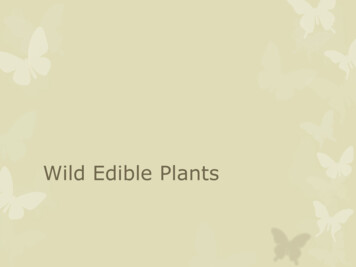
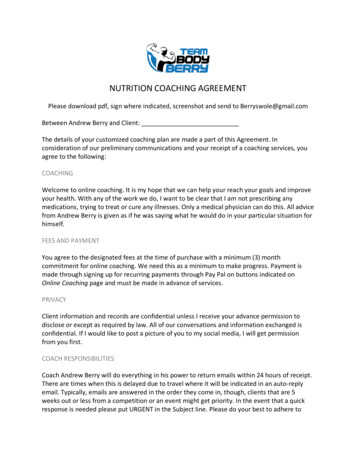
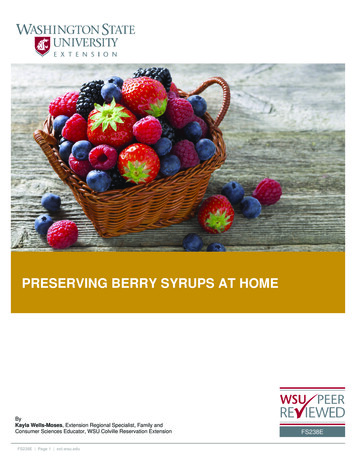
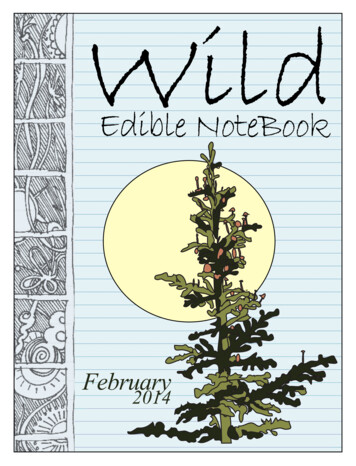

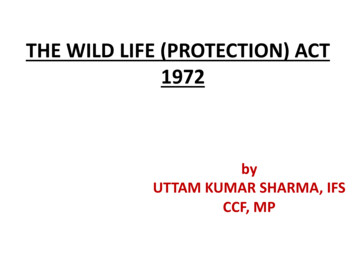
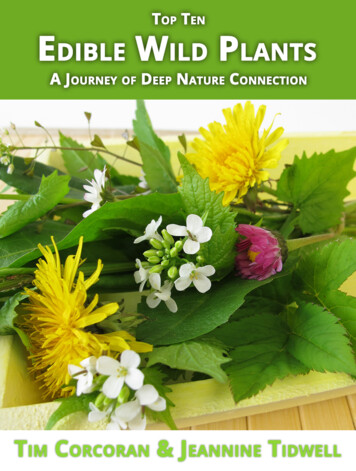
![INDEX [randycherry ]](/img/21/x-20-20tv-20fakebook-20-20hal-20leonard.jpg)
